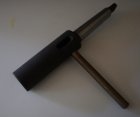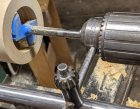The reply below was sent to me by a certain editor after I submitted a photo of a of a technique that guarantees that the chuck arbor will not spin in the tailstock when drilling on the lathe. The technique is inserting the long end of the chuck key handle into one of the 3 holes on the chuck and having the other end riding on the tool rest. The chuck key can also be used to ensure that the arbor doesn't break loose by pulling back on it as you retract the bit which of course is an advantage that is not present without it. The idea that the chuck key could bend or break is ridiculous considering that without it you would be depending on a tapered fit without a draw bar.
Please excuse my rant but it is hard to accept this kind of logic or should I say ilogic.
Note: I tried to down load a picture with the camera set for 12MP which has worked in the past but got the "file too big", then set at 6MP and still got the to big.
Hello Don,
Thank you for sending in this Tip. However, the solution you are presenting gave me pause and I hesitate to share it with the readership. I am not comfortable suggesting a chuck key be used in this manner, as it doesn’t seem safe. I imagine backing the bit out to clear the chips is further complicated. The bit could still get stuck in the wood, perhaps causing the chuck key to bend or break. The Morse taper of the drill chuck could still come loose from the quill. Generally, the setup feels like a questionable band-aid for the real issues, which might be a dull bit, scored or marred MT, etc., all the things discussed in Dennis Belcher’s article.
I appreciate your Tip submission, but with an abundance of caution for safety, I will have to decline to publish it.
Please excuse my rant but it is hard to accept this kind of logic or should I say ilogic.
Note: I tried to down load a picture with the camera set for 12MP which has worked in the past but got the "file too big", then set at 6MP and still got the to big.
Hello Don,
Thank you for sending in this Tip. However, the solution you are presenting gave me pause and I hesitate to share it with the readership. I am not comfortable suggesting a chuck key be used in this manner, as it doesn’t seem safe. I imagine backing the bit out to clear the chips is further complicated. The bit could still get stuck in the wood, perhaps causing the chuck key to bend or break. The Morse taper of the drill chuck could still come loose from the quill. Generally, the setup feels like a questionable band-aid for the real issues, which might be a dull bit, scored or marred MT, etc., all the things discussed in Dennis Belcher’s article.
I appreciate your Tip submission, but with an abundance of caution for safety, I will have to decline to publish it.




